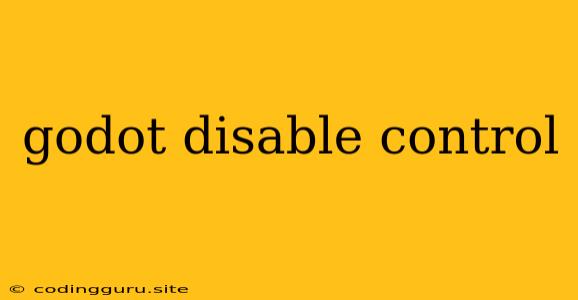How to Disable Controls in Godot Engine?
Godot Engine is a powerful and versatile game engine that provides a plethora of tools for creating interactive experiences. In game development, it's often necessary to temporarily disable player input or specific controls to achieve desired gameplay mechanics. This might be needed for cutscenes, dialogues, or even specific actions within the game. This article will guide you through various methods to disable controls in your Godot game.
Understanding Control Nodes in Godot
Before diving into the specifics of disabling controls, let's understand how Godot handles user input. Godot utilizes Control Nodes to manage input events like mouse clicks, key presses, and touch gestures. These nodes are responsible for responding to user actions and triggering events within your game. To disable controls, you essentially need to prevent these nodes from processing user input.
Disabling Controls: Methods and Examples
Here are the most common methods for disabling controls in Godot:
1. Disabling Input Processing:
* **`set_process_input(false)`:** This method, applied to a **Control Node**, effectively stops the node from processing any input events. This is a straightforward approach, but it disables all input for that specific control.
* **Example:**
```gdscript
extends Control
func _ready():
# Disable input for this Control Node
set_process_input(false)
```
2. Disabling Specific Input Events:
* **`_input(event)`:** Godot provides a built-in signal, `_input(event)`, which gets triggered when a user interacts with your game. Within this function, you can access information about the input event using the `event` parameter and selectively disable specific actions.
* **Example:**
```gdscript
extends Control
func _input(event):
if event is InputEventKey:
if event.scancode == KEY_SPACE:
# Disable space bar input
return
```
3. Disabling Controls Using Node States:
* **`set_process_mode(PROCESS_MODE_PAUSED)`:** This method pauses a node's processing and effectively disables all input events.
* **`set_process_mode(PROCESS_MODE_INACTIVE)`:** This method sets the node to an inactive state, preventing any further processing and disabling all input.
* **Example:**
```gdscript
extends Control
func _ready():
# Disable all input for this control
set_process_mode(PROCESS_MODE_PAUSED)
```
4. Disabling Controls Through Scripting:
* **`connect` method:** You can use Godot's `connect` method to listen for specific signals emitted by your nodes and then take action to disable controls.
* **Example:**
```gdscript
extends Control
func _ready():
# Connect to the 'pressed' signal of a button
get_node("Button").connect("pressed", self, "disable_controls")
func disable_controls():
# Disable input for the control node
set_process_input(false)
```
5. Disabling Controls using the "Input Map"
* The "Input Map" feature in Godot allows you to define custom mappings for various input actions. You can utilize this feature to toggle specific input actions by temporarily removing or modifying their bindings.
* **Example:**
* Create a new scene with a "Control" node.
* In the **Project Settings** > **Input Map**, add a new "Action" such as "DisableMovement".
* Bind the "DisableMovement" action to a key like the "Space" key.
* Create a script attached to your "Control" node with the following code:
```gdscript
extends Control
func _input(event):
if event is InputEventKey:
if event.scancode == KEY_SPACE:
# Toggle input map action
Input.set_action_strength("DisableMovement", 1.0)
```
* Now, when you press the "Space" key, the "DisableMovement" action will be activated.
* You can use this action to disable specific input events or controls based on your game logic.
Enabling Controls Back
Once you've disabled controls, you'll likely need to enable them back at some point. To re-enable controls, simply reverse the actions you took to disable them:
set_process_input(true)set_process_mode(PROCESS_MODE_NORMAL)- Remove the
returnstatement in the_input(event)function if you were selectively disabling specific input events. - Use the "Input Map" to re-enable the previously disabled input actions by setting the "strength" back to 0.0 or by removing the action binding.
Choosing the Right Method:
The most appropriate method for disabling controls depends on your specific game requirements. Consider factors like:
- How many controls need to be disabled: If you need to disable all controls, the "set_process_input" or "set_process_mode" methods are efficient.
- The duration of the disabling: If you're temporarily disabling controls for a short period, the "set_process_mode" methods or
_input(event)can be used. If it's a longer duration, using the "set_process_input" or "connect" method might be more suitable. - The complexity of your game logic: If your game logic requires a more nuanced approach, using "connect" or the "Input Map" methods for disabling controls might provide better control.
Conclusion
Disabling controls is a common technique in game development. By understanding the various methods for disabling controls in Godot, you can effectively manage player input and achieve the desired gameplay experiences. Remember to consider the specific requirements of your game when choosing the most suitable approach, and always ensure you re-enable controls when appropriate.
